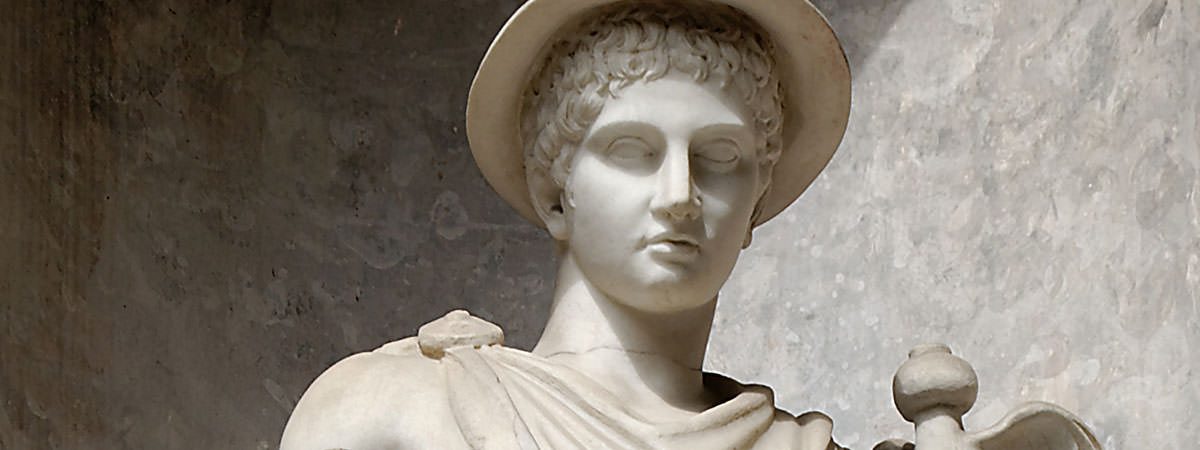In ancient Greece, Hermes was the ‘divine trickster’ who is considered as the herald of the Gods. Hermes is also considered as the protector of shepherds, thieves, merchants and travelers. He is the God of eloquence, commerce, cunning, astronomy and music. Hermes was later appropriated as Mercury in the Roman era. He was prominently worshiped as a God who presides over boundaries and gateways, one who had the capability to travel to the underworld and one who guided the dead souls into their afterlife. He is also the patron of athletes, gymnasts and the God of the art of fighting. The first known mention of Hermes is found in the late Bronze age Mycenaean period. However, the exact origins of his cult remain a mystery. He is usually depicted as a mature man, bearded, and dressed as a traveler or a herald. Hermes’ main symbol is the caduceus. The primary ancient Greek festival of Hermaea was held in his honor. Here are 10 facts regarding the herald of the Gods, Hermes.
#1 Earliest Written Record Of Hermes Comes From The Mycenaean Period
The earliest known references to Hermes (Roman Mercury) predate the ancient Greeks and are found in the tablets from the Mycenaean period, dating back to the Bronze Age in European history. Written in Liner B, these inscribed tablets show his name written as e‐ma‐a₂. They have been found in Pylos, Thebes and Knossos. It is interesting to note that Hermes’ name in these artifacts is always recorded along with female divinities like Potnija, Posidaeja, Diwja and Ipemedeja. This indicates that his cult was somehow associated with them. This trend is also noted to have been continued in ancient Greece where Hermes finds his presence in the sanctuaries of female divinities such as Hera’s, Hecate’s, the Muses’, Demeter’s and Despoina’s.
Main Sources:-
Radulovi, Ifigenija; Vukadinovi, Snežana; Smirnovbrki, Aleksandra. “Hermes the Transformer”. Estudos Clássicos em debate, núm. 17, 2015, P 45-46. Universidade de Aveiro, Portugal.
Notes:-
Mycenaean period | Estimated to 1750 to 1050 BC, it is recognized as the last phase of the Bronze Age in Greece. Home to the Mycenaean civilization that preceded the Ancient Greeks.
Liner B | A form of Bronze Age writing discovered on tablets in Crete.
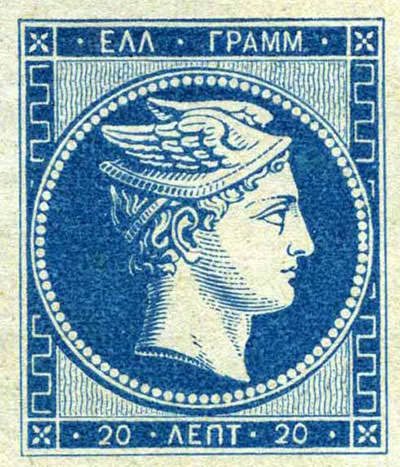
#2 The Festival Of Hermaea Was Celebrated In His Honor
The oldest surviving proof of the festival of Hermaea dates back to the 4th century BCE, though it may have been established as early as the 6th century BCE. The feast was dedicated to Hermes where sacrifices were made in honor of the God and young boys participated in games like athletics and gymnastics. Of all the festivals involving Greek games, these were most like initiations because participation in them was restricted to young boys and excluded adults. As Hermes was the tutelary deity of the gymnasia and palaestrae, the boys at Athens celebrated the Hermaea in the gymnasia. Other prominent places that are known to have hosted the festival include Crete and Pheneos in Arcadia, with Hermes being the principal deity of the later.
Main Sources:-
William Smith (editor). 1870. “Hermaea”, Dictionary of Greek and Roman Antiquities. p.604
Scanlon, Thomas Francis. “Eros and Greek athletics”. Oxford University Press, 2002. pp. 92–93.
Notes:-
Palaestrae | An area for training (for wrestling, boxing etc.) and exercises and part of a larger gymnasia. May exist independently as well.
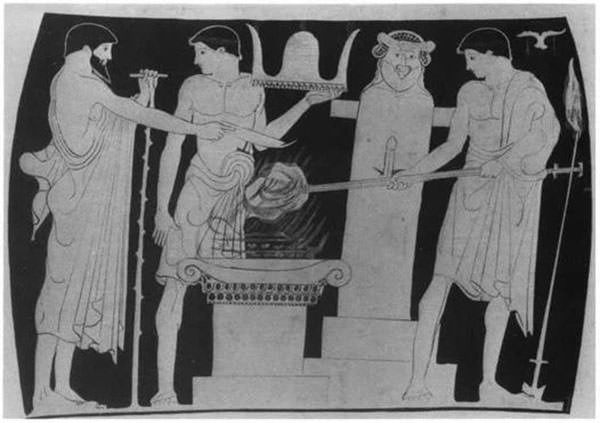
#3 He Was Revered As A Liminal Deity
Hermes in ancient Greece was prominently worshiped as a liminal deity; or as a god who presides over boundaries, gates, doorways and such. Sculptures (like herms) and other such iconography which represented him were thus placed at locations befitting his role. Like, in Athens, herms were placed outside houses and at the central agora marking the center of each village deme. The Hermai also functioned as boundary markers, roadside markers and grave markers. Another prominent and associated role of Hermes was that of a herald. He was referred to as the messenger of the Gods many times. Hermes was considered as a crosser of boundaries who could convey messages between the divine realms, the underworld and the world of mortals. He was thus also considered as a psycho pomp, or one who could cross the boundary of life and death and guide the souls of the deceased to the afterlife.
Main Sources:-
Radulovi, Ifigenija; Vukadinovi, Snežana; Smirnovbrki, Aleksandra. “Hermes the Transformer” Estudos Clássicos em debate, núm. 17, 2015, P 45-62. Universidade de Aveiro, Portugal.
W. Blackwood Ltd. (Edinburgh). Blackwood’s Edinburgh magazine, Volume 22; Volume 28. Leonard Scott & Co. 1849
Notes:-
Hermai | Herm | A rectangular, often tapering stone post bearing a carved head or bust, usually of Hermes, used as a boundary marker in ancient Greece and for decorative purposes in later periods.
Agora | Central public space in ancient Greek city-states
Deme | A political division of Attica in ancient Greece.
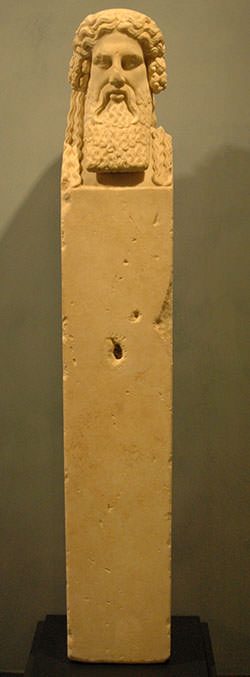
#4 Hermes Was Worshiped As A Shepherd God
Hermes Kriophoros or ‘Hermes as a Ram bearer’ is a common iconography which may be found in numerous depictions throughout the Mediterranean world. Hermes was considered as the patron God of the shepherds and flocks. According to myth, he once saved the town of Boeotia from plague, by carrying a ram or calf around the city walls. This event was celebrated in a yearly festival in Greece where the act of Hermes was repeated by “the most handsome boy” who would carry a ram around the city. The ram would then be sacrificed, in order to purify and protect the city from disease, drought and famine. This iconography of Hermes as “The Good Shepherd” may have influenced early Christianity, specifically in the description of Christ as “The Good Shepherd”.
Main Sources:-
Freeman, J. A., Jefferson, L. M., & Jensen, R. M. (2015). “The Good Shepherd and the Enthroned Ruler: A Reconsideration of Imperial Iconography in the Early Church. The Art of Empire”. Minneapolis, Augsburg Fortress.
#5 He Was A Symbol Of Fertility
The earliest form of worship of Hermes is understood to be in the form of a chthonic deity, or a divinity closely associated with the land or mother earth. Here he seemed to be closely associated with fertility (especially male) and the erect phallus was a symbol closely associated with him. Such imagery that have been found at the entrances to ancient Greek households may reflect a belief that Hermes was a symbol of the household’s fertility, specifically the potency of the male head of the household. Greek legends pertaining to Hermes portray him as a trickster, the youngest among the Olympians who is known for his mischief, cunning and insight. It is for these qualities that Hermes came to be considered as the god of thieves. Being a messenger, Hermes was also a traveler and, with time, his role may have expanded as the protector of travelers, roads and ships. He was thus also worshiped by sailors and travelers.
Main Sources:-
Radulovi, Ifigenija; Vukadinovi, Snežana; Smirnovbrki, Aleksandra. “Hermes the Transformer”. Estudos Clássicos em debate, núm. 17, 2015, P 45-62. Universidade de Aveiro, Portugal.
Ospino, Luis. Dec 2021. “Hermes, the God of Thieves in Ancient Greece”. Greek Reporter.
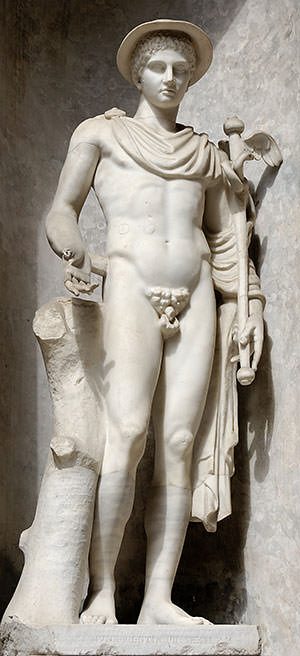
#6 He May Be Based On The Egyptian God Thoth
The origins of the cult of Hermes are difficult to establish from the available data. He may as well be the Vedic deity Sarama, the female dog and messenger of Indra. Hermes has also been thought identical to the Mesopotamian snake-god, similar or identical to Ningishzida, a god who served as mediator between humans and the divine. Among others, there are theories that identify Hermes to be based on the Egyptian God Thoth. Ancient historians like Herodotus and Plutarch were the first to identify the Greek God with the Egyptian city of Hermopolis, where the chief temple of Thoth was located.
Main Sources:-
Swaminathan, Santanam. 2015. “Vedic Sarama and Greek Hermes!!”. Speaking Tree
Debroy, Bibek (2008). “Sarama and her Children: The Dog in the Indian Myth”. P 77. Penguin Books India.
Frothingham, A.L. (1916). “Babylonian Origin of Hermes the Snake-God, and of the Caduceus”. P175-211.
Notes:-
Ishtar | important mother goddess of Mesopotamia
Thoth | Egyptian god of writing, magic, wisdom, and the moon
Herodotus | Ancient (484 BCE-425 BCE) Greek historian and geographer. known for having written the Histories, a detailed account of the Greco-Persian Wars.
Plutarch | Ancient (46-119 CE) Greco Roman historian, biographer and priest at the Temple of Apollo in Delphi.
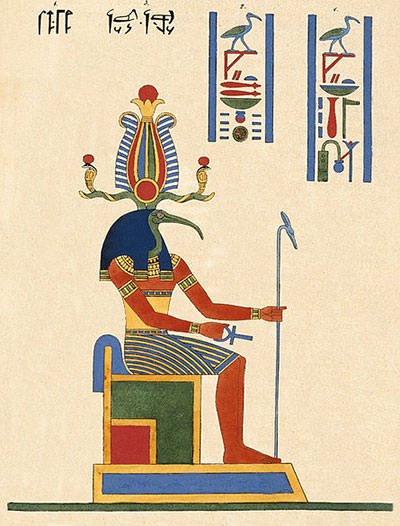
#7 He Was A Patron God Of Athletes
In archaic Greece, Hermes is seen mostly represented as a mature bearded man dressed as a traveler, herald or a shepherd. As a patron God of the athletes, he was also represented as young, unshaven and with an athletic body. The winged sandals (Greek pédila/ Roman talaria) are a well known symbol associated with the herald of the Gods which helped the herald to take the roads with speed. Another common symbol is the petasos, or the wide brimmed hat used in the times by the rural populace to protect themselves from the sun. Hermes may also be seen depicted with a satchel or pouch and wearing a robe or cloak. His weapon was a sword of gold, which killed Argos and was lent to Perseus to kill Medusa. Other symbols associated with him are the tortoise, lyre, olive tree, the erected phallus and of course the herma.
Main Sources:-
Smith, William. “Dictionary of Greek and Roman Biography and Mythology”. 1867. Little, Brown & Co. Boston. P411–413.
#8 The Caduceus Is His Most Prominent Symbol
The caduceus is considered as the most prominent symbol associated with Hermes. The Latin word cādūceus is an adaptation of the Greek κηρύκειον kērykeion, meaning “herald’s wand (or staff)”, deriving from κῆρυξ kēryx, meaning “messenger, herald, envoy”. The caduceus is a staff with two intertwined snakes, sometimes crowned with a pair of wings and a sphere. Hermes is mostly seen carrying the caduceus, which is said to have had the power to make people fall asleep or wake up. It is also said to have made peace between litigants. Moreover, if it was applied to the dying, their death was gentle; and if it was applied to the dead, they returned to life.
Main Sources:-
Liddell and Scott, Greek-English Lexicon; Stuart L. Tyson, “The Caduceus”, The Scientific Monthly, 34.6 (1932:492–98), P493
Godwin, William. (1876). “Lives of the Necromancers”. P37.

#9 There Are Only Three Known Temples Dedicated To Him In Ancient Greece
There are only three temples that are specifically known to have been dedicated to Hermes in ancient Greece. All these temples are located in Arcadia region of the Peloponnesus. Mount Kyllini or Mount Cyllene is located in the north of the Peloponnese peninsula, where Hermes is said to have been born at the home of his mother Maia, the eldest of the seven Pleiades. This is considered as the oldest place of worship of the God from where his cult may have been taken to Athens and spread to other areas. Though there are a few references in ancient literature to “numerous” temples of Hermes, this may be poetic license describing the ubiquitous herms, or other smaller shrines to Hermes, located in the temples of other deities. In the Roman period, additional temples to Hermes (Mercury) were constructed across the Roman Empire.
Main Sources:-
Radulovi, Ifigenija; Vukadinovi, Snežana; Smirnovbrki, Aleksandra. “Hermes the Transformer” Estudos Clássicos em debate, núm. 17, 2015, P 45-62. Universidade de Aveiro, Portugal.
Smith, William. “Dictionary of Greek and Roman Biography and Mythology”. 1867. Little, Brown & Co. Boston. P411–413.
Notes:-
Peloponnesus | A peninsula forming the S part of Greece: seat of the early Mycenaean civilization and the powerful city-states of Argos, Sparta, etc.
Pleiades | The seven daughters of the Titan Atlas and the Oceanid Pleione, who were pursued by the hunter Orion until Zeus changed them into a cluster of stars.
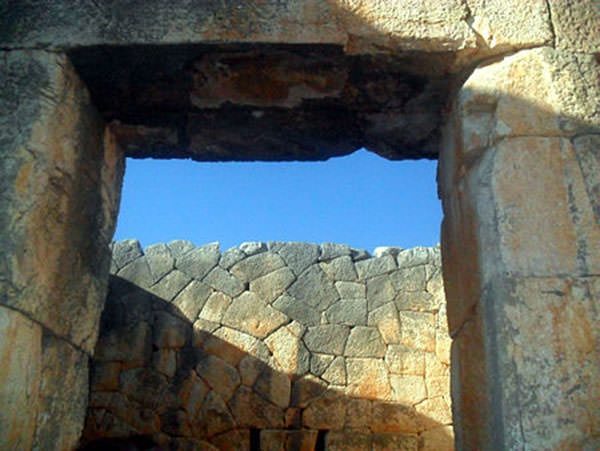
#10 He Is Associated With The Unconscious In Jungian Psychology
Carl Jung (1875-1961) was a noted Swiss psychoanalyst who is considered as the founder of analytical psychology. Hermes plays a crucial role in Jungian psychology, where the psychoanalyst equates him with the unconscious mind, more like a God of the unconscious. Hermes’s role as messenger between realms and as guide to the underworld is equated with him being a guide between the conscious and unconscious parts of the mind. In Jungian psychology, Hermes along with Pan and Dionysus is also seen as relevant to study of the phenomenon of synchronicity.
Main Sources:-
A Stevens. “On Jung”, Taylor & Francis, 1990
Miller, JC. 2004. “The Transcendent Function: Jung’s Model of Psychological Growth Through Dialogue With the Unconscious”. SUNY Press.
Main, Roderick. 2007. “Revelations of Chance; Synchronicity as Spiritual Experience”. State University of New York Press.
Notes:-
synchronicity | A phenomenon in which people interpret two separate—and seemingly unrelated—experiences as being meaningfully intertwined, even though there is no evidence for the same.

